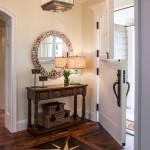How to Decorate a Kitchen Desk Area
The kitchen desk area, often an overlooked space, presents a valuable opportunity to blend functionality with aesthetic appeal. Whether it serves as a command center for household management, a homework station, or a casual workspace, careful decoration can transform this zone into an organized and visually pleasing part of the kitchen.
Effective decoration requires a thoughtful approach that considers the desk's primary purpose, the overall kitchen design, and personal preferences. A well-decorated kitchen desk area should not only be functional but also contribute to the overall harmony and ambiance of the kitchen space. This involves selecting appropriate furniture, storage solutions, and decorative elements that complement the existing style and maximize efficiency.
Prioritizing Functionality and Organization
The primary function of a kitchen desk area is to provide a designated workspace. Therefore, prioritizing functionality and organization is paramount when decorating. Clutter can quickly accumulate in this area, leading to inefficiency and a visually unappealing space. Effective organization is the foundational element of a successful kitchen desk area.
Start by assessing the desk's intended use. Will it primarily serve as a bill-paying station, a recipe hub, or a homework area? This understanding will inform the selection of necessary tools and storage solutions. For example, a bill-paying station requires filing cabinets, organizers for bills and receipts, and potentially a shredder for sensitive documents. A recipe hub might benefit from cookbook stands, recipe card organizers, and a dedicated tablet holder.
Consider incorporating vertical storage solutions to maximize space. Wall-mounted shelves, pegboards, and hanging organizers can effectively utilize vertical space and keep frequently used items within easy reach. These solutions are particularly beneficial for smaller desk areas where surface space is limited. Shelving can house cookbooks, decorative items, or even small plants, adding visual interest while maintaining organization.
Desk organizers are crucial for maintaining a clutter-free workspace. Utilize drawer dividers, pen holders, and file organizers to keep essential items neatly arranged. Consider transparent organizers to easily identify the contents without having to rummage through drawers. Labeling organizers can also facilitate efficient retrieval of items and ensure everything is returned to its designated place. A well-organized desk promotes productivity and reduces stress.
Invest in cable management solutions to keep cords and wires neatly organized and out of sight. Cord organizers, clips, and sleeves can prevent tangled cords and create a cleaner, more professional appearance. This is particularly important for desks with multiple electronic devices, such as computers, printers, and charging stations. Proper cable management not only improves the aesthetic appeal but also reduces the risk of tripping hazards and electrical damage.
Consider the lighting in the desk area. Adequate lighting is essential for both functionality and aesthetics. A task lamp with adjustable brightness and direction can provide focused illumination for specific tasks, such as reading or writing. Natural light is also beneficial, but it should be supplemented with artificial light to ensure sufficient illumination throughout the day. Choose a lamp style that complements the overall kitchen design and provides adequate light without creating glare.
Integrating Style and Aesthetics
While functionality is essential, the aesthetic appeal of the kitchen desk area should not be overlooked. Integrating style and aesthetics can transform this functional space into a visually pleasing element of the kitchen. The goal is to create a cohesive design that complements the overall kitchen style and reflects personal preferences.
Start by considering the existing kitchen design. The desk area should seamlessly integrate with the overall style and color scheme. For example, in a modern kitchen, a sleek desk with minimalist accessories and neutral colors would be appropriate. In a rustic kitchen, a wooden desk with vintage-inspired accents would be a better fit. Maintaining a consistent style creates a harmonious and visually appealing space.
Incorporate decorative elements to add personality and visual interest. Artwork, photographs, and decorative objects can personalize the desk area and reflect individual tastes. Choose items that are both aesthetically pleasing and meaningful. Consider incorporating a small vase of flowers, a framed family photo, or a piece of art that complements the kitchen's color scheme. However, avoid overcrowding the desk with too many decorative items, as this can detract from the functionality and create a cluttered appearance.
The choice of desk accessories can also contribute to the overall style. Select accessories that are both functional and aesthetically pleasing. For example, a stylish pen holder, a decorative tape dispenser, or a unique paperweight can add a touch of personality to the desk area. Consider using accessories made from materials that complement the kitchen's design, such as wood, metal, or glass.
Textiles can also play a role in enhancing the aesthetics of the desk area. A comfortable chair cushion or a small rug can add warmth and texture to the space. Choose textiles that are durable and easy to clean, as the kitchen environment can be prone to spills and stains. Consider using textiles with patterns or colors that complement the kitchen's color scheme.
Incorporate plants to add a touch of nature to the desk area. Plants can brighten up the space, purify the air, and create a more relaxing atmosphere. Choose low-maintenance plants that thrive in indoor environments, such as succulents, snake plants, or pothos. Consider placing plants on shelves, on the desk itself, or in hanging planters. However, be mindful of the amount of sunlight the desk area receives and choose plants accordingly.
Pay attention to the details, such as the hardware on drawers and cabinets. Replacing existing hardware with stylish knobs or pulls can instantly elevate the look of the desk area. Choose hardware that complements the kitchen's overall design and adds a touch of sophistication. Consider using hardware made from materials such as brushed nickel, stainless steel, or antique brass.
Optimizing the Workspace for Ergonomics and Comfort
An often-overlooked aspect of decorating a kitchen desk area is ergonomics and comfort. Spending extended periods at a poorly designed workspace can lead to discomfort, fatigue, and even health problems. Optimizing the workspace for ergonomics and comfort is essential for both productivity and well-being.
Start by selecting a chair that provides adequate support and comfort. An ergonomic chair with adjustable height, lumbar support, and armrests is ideal. The chair should allow the user to sit with their feet flat on the floor, their knees at a 90-degree angle, and their back straight. Consider investing in a chair cushion for added comfort, especially if the chair is used for extended periods.
Ensure that the desk is at the appropriate height. The keyboard and mouse should be positioned at a height that allows the user to keep their wrists straight and their elbows at a 90-degree angle. If the desk is too high, consider using a footrest to elevate the feet and maintain proper posture. If the desk is too low, consider raising the desk with risers or adjustable legs.
Position the monitor at eye level to prevent neck strain. The top of the monitor should be slightly below eye level. If using a laptop, consider using a laptop stand to raise the screen to the appropriate height. An external keyboard and mouse can also improve ergonomics when using a laptop at a desk.
Take frequent breaks to stretch and move around. Spending long periods sitting in one position can lead to muscle stiffness and fatigue. Take short breaks every 20-30 minutes to stretch, walk around, and rest the eyes. Consider using a timer to remind oneself to take regular breaks.
Consider the placement of the desk in relation to natural light. Position the desk so that natural light comes from the side, rather than directly in front or behind. Direct sunlight can cause glare and eye strain. If natural light is unavoidable, consider using window blinds or shades to control the amount of light entering the room.
Organize the workspace to minimize reaching and stretching. Keep frequently used items within easy reach to prevent unnecessary strain on the body. Position the keyboard, mouse, and phone close to the body, and keep less frequently used items further away. Consider using a desk organizer or drawer dividers to keep items neatly arranged and easily accessible.
By prioritizing functionality, integrating style, and optimizing for ergonomics, the kitchen desk area can be transformed into a valuable and aesthetically pleasing space within the home. Careful planning and attention to detail can create a workspace that is both productive and enjoyable.

Que Tal Um Escritório Rústico Em Casa Kitchen Desk Areas Home Office Design Decor

Kitchen Desk Ideas Driven By Decor

20 Clever Ideas To Design A Functional Office In Your Kitchen

Love It Or Leave The Built In Kitchen Desk

How To Overcome The Kitchen Desk Blues Feathering My Empty Nest

Making Use Of Our Unused Desk Area In The Kitchen Used Leftover Oak Flooring And Recycled Wine Crates I Areas Remodel Small Decor

Kitchen Desk Yes Or No

Desk Area In Kitchen Design Ideas

Kitchen Desk Yes Or No

Kitchen Desks Outdated Say It Ain T So







